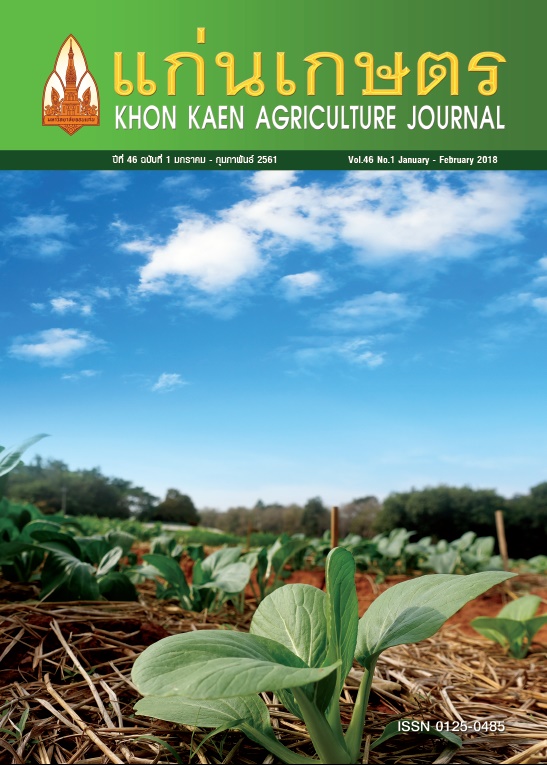การตรวจสอบสารพฤกษเคมีเบื้องต้นและผลความเป็นพิษต่อพืชของสารสกัดหยาบจากใบไมยราบ (Mimosa pudica L.)
Main Article Content
บทคัดย่อ
วัชพืชหลายชนิดสามารถผลิตสารออกฤทธิ์ทางชีวภาพ ซึ่งสามารถนำมาใช้เป็นสารควบคุมวัชพืชได้ วัตถุประสงค์ของการศึกษานี้เพื่อตรวจสอบสารพฤกษเคมีเบื้องต้นและความเป็นพิษต่อการเจริญเติบโตของพืชของสารสกัดหยาบจากใบไมยราบ (Mimosa pudica L.) โดยสกัดใบไมยราบด้วยสารละลายเมทานอล 80% ที่ 4 ความเข้มข้น ได้แก่ 0, 25, 50 และ 100 กรัม น้ำหนักแห้ง/ลิตร จากผลการทดลอง พบสารพฤกษเคมี จำนวน 6 กลุ่ม ได้แก่ แทนนิน ฟลาโวนอยด์ แอลคาลอยด์ เทอร์พีนอยด์ โฟลบาแทนนิน และซาโปนิน ปริมาณสารประกอบฟีนอลและฟลาโวนอยด์อยู่ในช่วง 186.12 ± 17.76 - 618.44 ± 43.01 มก. GAE/มล. และ 133.69 ± 6.63 - 470.60 ± 26.91 มก. QE/มล. ตามลำดับ การศึกษาความเป็นพิษต่อพืชของสารสกัด พบว่า สารสกัดสามารถยับยั้งการงอกของเมล็ด ความยาวของราก และความยาวของส่วนยอดในผักกาดหอม ผักกาดเขียวปลี และข้าว อย่างมีนัยสำคัญ เมื่อความเข้มข้นของสารสกัดสูงขึ้น อัตราการยับยั้งมีแนวโน้มเพิ่มขึ้น โดยสารสกัดสามารถยับยั้งการงอกของเมล็ดและการเติบโตในผักกาดหอมและผักกาดเขียวปลีได้อย่างมีประสิทธิผลมากกว่าในข้าว ผลการศึกษาแสดงให้เห็นว่า สารสกัดจากใบไมยราบอาจเป็นแหล่งของสารออกฤทธิ์ทางชีวภาพที่มีผลต่อการเจริญเติบโตของพืช
Article Details
เอกสารอ้างอิง
ดวงพร สุวรรณกุล. 2543. ชีววิทยาวัชพืช พื้นฐานการจัดการวัชพืช. สำนักพิมพ์มหาวิทยาลัยเกษตรศาสตร์, กรุงเทพฯ. รังสิต สุวรรณเขตนิคม. 2547. สารป้องกันกำจัดวัชพืช พื้นฐานและวิธีการใช้. สำนักพิมพ์มหาวิทยาลัยเกษตรศาสตร์, กรุงเทพฯ.
อินทิรา ขูดแก้ว. 2559. ผลทาง allelopathy ของวัชพืชบางชนิดต่อการงอกและการเติบโตของผักกาดหอม (Lactuca sativa L.). แก่นเกษตร. 44(ฉบับพิเศษ 1): 771-776.
อินทิรา ขูดแก้ว, กนกรัตน์ บุญรักษา, และปรียานุช สำลี. 2559. ผลของสารสกัดหยาบจากไมยราบและหญ้าขนต่อการงอกและการเติบโตของต้อยติ่ง. แก่นเกษตร. 44(ฉบับพิเศษ 1): 777-782.
Anjum, T., R. Bajwa, and A. Javaid. 2005. Biological control of Parthenium I: Effect of Imperata cylindrica on distribution, germination and seedling growth of Parthenium hysterophorus L. Int. J. Agric. Biol. 7: 448-450.
Arokiyaraj, S., N. Sripriya, R. Bhagya, B. Radhika, L. Prameela, and N.K. Udayaprakash. 2012. Phytochemical screening, antibacterial and free radical scavenging effects of Artemisia nilagirica, Mimosa pudica and Clerodendron siphonanthus-An in-vitro study. Asian Pac. J. Trop. Biomed. S: 601-S602.
Fayez, K.A., and U. Kristen. 1996. The influence of herbicides on the growth and proline content of primary roots and on the ultrastructure of root caps. Environ. Exp. Bot. 36: 71-81.
Fujii, Y. 2009. Overview of research on allelochemicals. W3-01, pp. 1-4. In: Macro Symposium: Challenges for
Agro-Environmental Research in Monsoon Asia 5-7 October 2009. National Institute of Agro-Environmental Sciences (NIAES), Ibaraki, Japan.
Kato-Noguchi, H., A. Kobayashi, O. Ohno, F. Kimura, Y. Fujii, and K. Suenaga. 2014. Phytotoxic substances with allelopathic activity may be central to the strong invasive potential of Brachiaria brizantha. J. Plant Physiol. 171: 525-530.
Harborne, J.B. 1973. Phytochemical Methods. Chapman and Hall, Ltd, London.
Li, Z.H., Q. Wang, X. Ruan, C.D. Pan, and D.A. Jiang. 2010. Phenolics and plant allelopathy. Molecules 15: 8933-8952.
Muhammad, G., M.A. Hussain, I. Jantan, and S.N.A. Bukhari. 2016. Mimosa pudica L., a high-value medicinal plant as a source of bioactives for phamaceuticals. Compr. Rev. Food Sci. Food Saf. 15: 303-315.
Pérez, A.J., A.M. Simonet, L. Pecio, M. Kowalczyk, J.M. Calle, F.A. Macías, W. Oleszek, and A. Stochmal. 2015. Triterpenoid saponins from the aerial parts of Trifolium argutum Sol. and their phytotoxic evaluation. Phytochem. Lett. 13: 165-170.
Qasem, J.R., and C.L. Foy. 2001. Weed allelopathy, its ecological impacts and future prospects. J. Crop Prod. 4: 43 119.
Rice, E. L. 1984. Allelopathy. 2nd edition. Academic Press, Orlando.
Rosado-Vallado, M., W. Brito-Loeza, G.J. Mena-Rejon, E. Quintero-Marmol, and J.S. Flores-Guido. 2000. Antimicrobial activity of Fabaceae species used in Yucatan traditional medicine. Fitoterapia 71: 570-573.
Singleton, V.L., R. Orthofer, and R.M. Lamuela-Ravenros. 1999. Analysis of total phenols and other oxidation substrates and antioxidants by means of Folinciocalteu reagent. Methods Enzymol. 299: 152-178.
Tawatsin, A., U. Thavara, and P. Siriyasatien. 2015. Pesticides used in Thailand and toxic effects to human health. Med. Res. Arch. 3: 1-10.
Trease, G.E., and W.C. Evans. 2002. Pharmacognosy. 15th edition. W.B. Saunders, Edinburgh.
Tunna, T.S., I.S.M. Zaidul, Q.U. Ahmed, K. Ghafoor, F.Y. Al-Juhaimi, M.S. Uddin, M. Hasan, and S. Ferdous. 2015. Analyses and profiling of extract and fractions of neglected weed Mimosa pudica Linn. traditionally used in Southeast Asia to treat diabetes. S. Afr. J. Bot. 99: 144-152.
Uddin, M.B., R. Ahmed, S.A. Mukul, and M.K. Hossain. 2007. Inhibitory effect of Albizia lebbeck leaf extracts on germination and growth behavior of some popular agricultural crops. J. For. Res. 18: 128-132.
Yuan, K., J. Zhu, and J. Xin. 2007. Two new C-glycosylflavones from Mimosa pudica. Chin. Chem. Lett. 18: 1231-1234.
Yusuf, U. K., N. Abdullah, B. Baker, K. Itam, F. Abdullah, and M. Sukari. 2003. Flavonoid glycosides in the leaves of Mimosa species. Biochem. Syst. Ecol. 31: 443-445.


